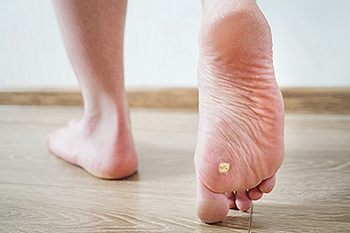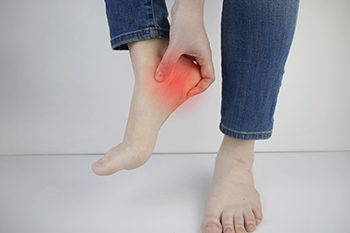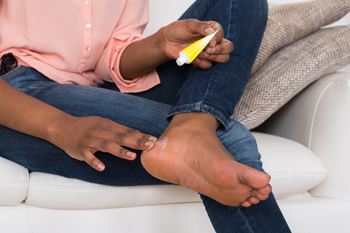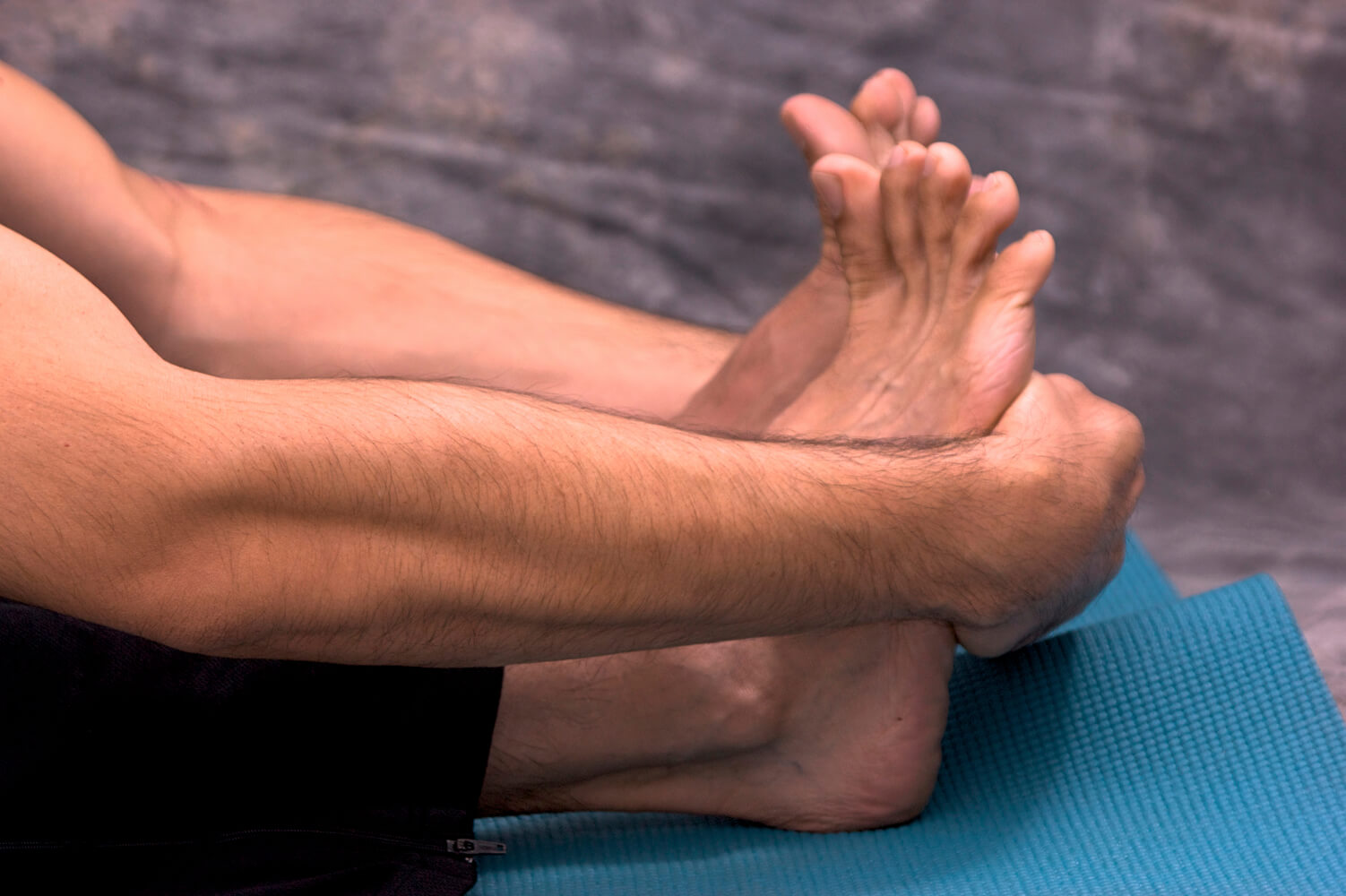Items filtered by date: August 2021
Toenail Fungus and Dietary Habits
The medical condition known as toenail fungus is often noticed by discoloration of the toenails. The nail may appear to be thick and yellow, and in severe cases sometimes the nail may become brittle and fall off. Some patients find it helpful to incorporate anti-fungal foods as part of their daily eating habits. Research has suggested it may be beneficial to eat foods that are made with specific ingredients and oils that may improve the quality of the bacteria in the gut. Some of the foods that may help to keep the body healthy can include fresh vegetables, chicken, and fish. Eating these types of foods may be instrumental in improving the immune system and are often considered when beginning treatment for toenail fungus. If you are afflicted with this ailment or have recurring fungal toenails, it is suggested that you consult with a podiatrist as quickly as possible who can determine what the best treatment methods are for you.
For more information about treatment, contact Leonora Fihman, DPM of California. Our doctor can provide the care you need to keep you pain-free and on your feet.
Toenail Fungus Treatment
Toenail fungus is a condition that affects many people and can be especially hard to get rid of. Fortunately, there are several methods to go about treating and avoiding it.
Antifungals & Deterrence
Oral antifungal medicine has been shown to be effective in many cases. It is important to consult with a podiatrist to determine the proper regiment for you, or potentially explore other options.
Applying foot powder on the feet and shoes helps keep the feet free of moisture and sweat.
Sandals or open toed shoes – Wearing these will allow air movement and help keep feet dry. They also expose your feet to light, which fungus cannot tolerate. Socks with moisture wicking material also help as well.
If you have any questions please feel free to contact our offices located in Encino and Brentwood, Los Angeles, CA . We offer the newest diagnostic tools and technology to treat your foot and ankle needs.
Understanding Warts on the Feet
 A verruca is a small wart on the sole of the foot. They are more commonly known as plantar warts. Plantar warts can grow on the sole of the foot because of the human papillomavirus (HPV). This virus is contagious and thrives in warm and moist environments like locker rooms and swimming pools which makes plantar warts common for people who are barefoot in these communal areas. Plantar warts are not usually painful unless they are bearing weight. Some patients have found they may be tender to the touch as well. To avoid the spread of plantar warts, you should wear flip flops in communal areas such as pools, locker rooms, or showers. If you have a plantar wart that persists, consulting with a podiatrist and getting professional advice can be extremely beneficial.
A verruca is a small wart on the sole of the foot. They are more commonly known as plantar warts. Plantar warts can grow on the sole of the foot because of the human papillomavirus (HPV). This virus is contagious and thrives in warm and moist environments like locker rooms and swimming pools which makes plantar warts common for people who are barefoot in these communal areas. Plantar warts are not usually painful unless they are bearing weight. Some patients have found they may be tender to the touch as well. To avoid the spread of plantar warts, you should wear flip flops in communal areas such as pools, locker rooms, or showers. If you have a plantar wart that persists, consulting with a podiatrist and getting professional advice can be extremely beneficial.
Plantar warts can be very uncomfortable. If you need your feet checked, contact Leonora Fihman, DPM from California. Our doctor will assist you with all of your foot and ankle needs.
About Plantar Warts
Plantar warts are the result of HPV, or human papillomavirus, getting into open wounds on the feet. They are mostly found on the heels or balls of the feet.
While plantar warts are generally harmless, those experiencing excessive pain or those suffering from diabetes or a compromised immune system require immediate medical care. Plantar warts are easily diagnosed, usually through scraping off a bit of rough skin or by getting a biopsy.
Symptoms
- Lesions on the bottom of your feet, usually rough and grainy
- Hard or thick callused spots
- Wart seeds, which are small clotted blood vessels that look like little black spots
- Pain, discomfort, or tenderness of your feet when walking or standing
Treatment
- Freezing
- Electric tool removal
- Laser Treatment
- Topical Creams (prescription only)
- Over-the-counter medications
To help prevent developing plantar warts, avoid walking barefoot over abrasive surfaces that can cause cuts or wounds for HPV to get into. Avoiding direct contact with other warts, as well as not picking or rubbing existing warts, can help prevent the further spread of plantar warts. However, if you think you have developed plantar warts, speak to your podiatrist. He or she can diagnose the warts on your feet and recommend the appropriate treatment options.
If you have any questions please feel free to contact our offices located in Encino and Brentwood, Los Angeles, CA . We offer the newest diagnostic and treatment technologies for all your foot and ankle needs.
Causes and Symptoms of Plantar Fasciitis
 Plantar fasciitis is one of the most common causes of pain in the heel. This condition can occur when the plantar fascia, which is a band of tissue that runs from the bottom of the heel to the front of the foot, becomes inflamed or torn. Generally, plantar fasciitis is considered to be an overuse injury. There are other issues such as foot biomechanics, ill-fitted footwear, being overweight, or having tight calf muscles that can lead to an increased risk of plantar fasciitis as well. Plantar fasciitis usually results in heel pain that gradually worsens over time, tenderness when pressing onto the heel, and heel pain that is worse in the morning. Patients who notice any of the symptoms of heel pain or plantar fasciitis should consult with a podiatrist for a proper diagnosis and treatment for their condition.
Plantar fasciitis is one of the most common causes of pain in the heel. This condition can occur when the plantar fascia, which is a band of tissue that runs from the bottom of the heel to the front of the foot, becomes inflamed or torn. Generally, plantar fasciitis is considered to be an overuse injury. There are other issues such as foot biomechanics, ill-fitted footwear, being overweight, or having tight calf muscles that can lead to an increased risk of plantar fasciitis as well. Plantar fasciitis usually results in heel pain that gradually worsens over time, tenderness when pressing onto the heel, and heel pain that is worse in the morning. Patients who notice any of the symptoms of heel pain or plantar fasciitis should consult with a podiatrist for a proper diagnosis and treatment for their condition.
Plantar fasciitis can be very painful and inconvenient. If you are experiencing heel pain or symptoms of plantar fasciitis, contact Leonora Fihman, DPM from California. Our doctor can provide the care you need to keep you pain-free and on your feet.
What Is Plantar Fasciitis?
Plantar fasciitis is the inflammation of the thick band of tissue that runs along the bottom of your foot, known as the plantar fascia, and causes mild to severe heel pain.
What Causes Plantar Fasciitis?
- Excessive running
- Non-supportive shoes
- Overpronation
- Repeated stretching and tearing of the plantar fascia
How Can It Be Treated?
- Conservative measures – anti-inflammatories, ice packs, stretching exercises, physical therapy, orthotic devices
- Shockwave therapy – sound waves are sent to the affected area to facilitate healing and are usually used for chronic cases of plantar fasciitis
- Surgery – usually only used as a last resort when all else fails. The plantar fascia can be surgically detached from the heel
While very treatable, plantar fasciitis is definitely not something that should be ignored. Especially in severe cases, speaking to your doctor right away is highly recommended to avoid complications and severe heel pain. Your podiatrist can work with you to provide the appropriate treatment options tailored to your condition.
If you have any questions please feel free to contact our offices located in Encino and Brentwood, Los Angeles, CA . We offer the newest diagnostic and treatment technologies for all your foot and ankle needs.
What Causes Cracked Heels and How to Prevent Them
Cracked heels can be unsightly and uncomfortable with yellowing, thickened calluses, and visible splits in the skin. Dry skin is a common cause of cracked heels and in some cases that dry skin is the result of eczema, psoriasis, arthritis, or cold dry climates. Left untreated, cracked heels can be particularly problematic for people with diabetes as the fissures can deepen, bleed, and turn into open ulcers that may become infected. You can help prevent cracked heels from developing by exfoliating and moisturizing your feet regularly, avoiding walking barefoot or wearing open-heeled shoes, and inserting heel cups into shoes which decreases stress on your heels. If you have cracked heels and believe they may be infected, a podiatrist can provide a variety of treatments as well as additional tips on how to prevent them from reoccurring.
Cracked heels are unsightly and can cause further damage to your shoes and feet. If you have any concerns, contact Leonora Fihman, DPM from California. Our doctor can provide the care you need to keep you pain-free and on your feet.
Cracked Heels
Cracked heels appear unappealing and can make it harder for you walk around in sandals. Aside from looking unpleasant, cracked heels can also tear stockings, socks, and wear out your shoes. There are several methods to help restore a cracked heel and prevent further damage.
How Do You Get Them?
Dry skin is the number one culprit in creating cracked heels. Many athletes, walkers, joggers, and even swimmers suffer from cracked heels. Age and skin oil production play a role to getting cracked heels as well.
Promote Healing
Over the counter medicines can help, especially for those that need instant relief or who suffer from chronic dry feet.
Wear Socks – Wearing socks with medicated creams helps lock in moisture.
Moisturizers – Applying both day and night will help alleviate dryness which causes cracking.
Pumice Stones – These exfoliate and remove dead skin, which allows for smoother moisturizer application and better absorption into the skin.
Change in Diet
Eating healthy with a well-balanced diet will give the skin a fresh and radiant look. Your body responds to the kinds of food you ingest. Omega-3 fatty acids and zinc supplements can also revitalize skin tissue.
Most importantly, seek professional help if unsure how to proceed in treating cracked heels. A podiatrist will help you with any questions or information needed.
If you have any questions, please feel free to contact our offices located in Encino and Brentwood, Los Angeles, CA . We offer the newest diagnostic and treatment technologies for all your foot care needs.
Reasons to Stretch Your Feet
When thinking of stretching, we rarely think of the feet. Do they really need to be stretched? Don’t they get enough of a workout from just walking? Although it may not seem like a productive use of time on the surface, stretching the feet has many benefits. As with any other part of the body, stretching improves flexibility. In the feet, this can improve overall mobility and help prevent injuries. Stretching is also a good way to relieve aches and pains from working out, wearing uncomfortable shoes, or previous injuries. There are many easy, fast, and effective stretches that you can do throughout the day. To learn more about the benefits of stretching the feet, please consult with a podiatrist.
Why Stretching Is Important for Your Feet
Stretching the feet is a great way to prevent injuries. If you have any concerns with your feet consult with Leonora Fihman, DPM from California. Our doctor will assess your condition and provide you with quality foot and ankle treatment.
Stretching the Feet
Stretching the muscles in the foot is an important part in any physical activity. Feet that are tight can lead to less flexibility and make you more prone to injury. One of the most common forms of foot pain, plantar fasciitis, can be stretched out to help ease the pain. Stretching can not only ease pain from plantar fasciitis but also prevent it as well. However, it is important to see a podiatrist first to determine if stretching is right for you. Podiatrists can also recommend other ways to stretch your feet. Once you know whether stretching is right for you, here are some excellent stretches you can do.
- Using a foam roller or any cylindrical object (a water bottle or soda can will do), roll the object under your foot back and forth. You should also exert pressure on the object. Be sure to do this to both feet for a minute. Do this exercise three times each.
- Similar to the previous exercise, take a ball, such as a tennis ball, and roll it under your foot while seated and exert pressure on it.
- Grab a resistance band or towel and take a seat. If you are using a towel, fold it length wise. Next put either one between the ball of your foot and heel and pull with both hands on each side towards you. Hold this for 15 seconds and then switch feet. Do this three times for each foot.
- Finally hold your big toe while crossing one leg over the other. Pull the toe towards you and hold for 15 seconds. Once again do this three times per foot.
It is best to go easy when first stretching your foot and work your way up. If your foot starts hurting, stop exercising to ice and rest the foot. It is advised that you then see a podiatrist for help.
If you have any questions, please feel free to contact our offices located in Encino and Brentwood, Los Angeles, CA . We offer the newest diagnostic and treatment technologies for all your foot care needs.




